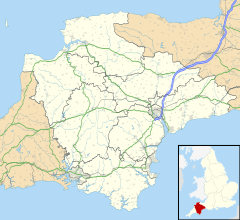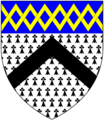Colebrooke, Devon facts for kids
Quick facts for kids Colebrooke |
|
|---|---|
| Population | 411 (2001 UK Census) |
| OS grid reference | SS770000 |
| District | |
| Shire county | |
| Region | |
| Country | England |
| Sovereign state | United Kingdom |
| Police | Devon and Cornwall |
| Fire | Devon and Somerset |
| Ambulance | South Western |
| EU Parliament | South West England |
Colebrooke is a small village and parish located in Devon, England. It's about 8 kilometers (5 miles) west of the town of Crediton.
This village is known for its historic church. It also has connections to famous people and stories. For example, Henry Kingsley wrote a novel called The Recollections of Geoffry Hamlyn which features Colebrooke.
You might know Uncle Tom Cobley from the famous folk song. He signed his will at Pascoe House in Colebrooke, but he is buried a few miles away in Spreyton.
Another notable person from Colebrooke was Abraham Cann. He was a champion Devon wrestler who was born and buried here. He even won a big wrestling competition in London!
Interestingly, Colebrooke also gave its name to a place across the ocean: Colebrook, Connecticut in the United States.
Contents
Discovering Ancient Roads
What is an Agger?
An agger is a raised road or embankment built by the Romans. They built these to make their roads strong and easy to travel on.
Roman Road Remains
You can still see parts of a Roman road near Colebrooke. The remains of an agger are visible in a field about 300 meters (about 1,000 feet) south of Rag Lane. It's also just east of a place called Five Acre Copse.
You can even spot this ancient road clearly if you look at aerial views online! The road follows a straight line all the way from North Tawton to this spot. After that, its path becomes a bit harder to see.
Exploring Colebrooke's Past
The Roman Fort Story
For a while, people thought there might have been a Roman fort or marching camp just east of Colebrooke village. However, there's no real proof for this idea.
It seems this belief came from a square field that sat across some straight hedgerows. In the 1980s, this field was mistakenly thought to be part of a Roman road leading to Exeter. This was mentioned in a book called 'Devon's Past an Aerial View' by Frances Griffith. Since then, two of the hedgerows in that field have been removed.
Historic Houses and Families
Colebrooke has been home to important families and their estates for centuries.
The Coplestone Family and Cross
The Coplestone family got their name from the manor of Copleston in Colebrooke parish. This family has a very long history in Devon.
There's a famous old rhyme about them:
- "Crocker, Cruwys and Copplestone,
- When The Conqueror came were all at home".
However, historians say this rhyme isn't actually true!
The Coplestone family lived at Coplestone House from the 1200s until 1659. The house you see today was rebuilt in 1787.
You can also find the Coplestone Cross nearby. It's a tall, 10-foot-high granite stone cross from the late Saxon period. It stands where the parishes of Colebrooke, Crediton, and Down St Mary meet.
Horwell Barton
Horwell was another important residence in Colebrooke. From the 1500s, it was home to the Prye family.
An old writer named Tristram Risdon (who lived in the 1600s) wrote something interesting about the Prye family. He said that for many generations, they never had a younger brother! This meant their family name was only found in this one place.
The house known today as Horwell Barton has a front that was built in the early 1800s.
St Andrew's Church
The parish church of St Andrew in Colebrooke holds some interesting historical monuments.
Inside the church, you can see a monument dedicated to Elizabeth Mills. She passed away on September 27, 1667. Elizabeth was the daughter of John Mills of Colebrooke. She was also the wife of Sir John Coryton, 1st Baronet. Her monument has fancy Corinthian columns and decorative scrollwork.
Images for kids





